GENUINE RATTLER 50 / 110
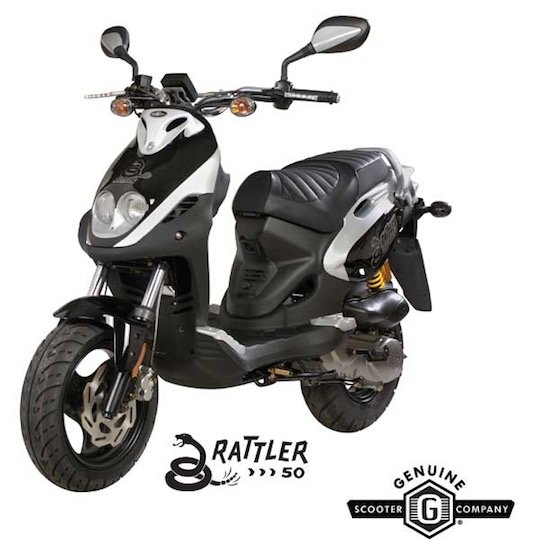
The Rattler 110 (aka Buck Ten) was introduced for 2008 and enjoyed a three year run through 2010. The Rattler 110 used the same basic design as the departed Rattler 50 (PGO PMS-Naked), but with twice the motor and bold new headlights that offered a much stronger bug-eye look. These lights are reminiscent of Yamaha’s Zuma scooter. These new larger lights were also added to the Roughhouse 50, making the Rattler and Roughhouse scooters very similar in appearance.
The Rattler Buck Ten lived a short (2008 – 2010) but much loved run, after which it could no longer meet increasingly stringent emissions regulations. Due to various reasons, the Rattler 110 was never sold in California just like the 2-stroke Stella.
Model Background
The Rattlers were built via Genuine’s collaboration by PGO Scooters of Taiwan and was based on their popular ‘PM’ design (model code PM-50DN or 110DN). More specifically, the Ratter was based on the PMS Naked variant of the PM design, with ’S’ standing for sport and ‘Naked’ referring to the exposed handlebars.
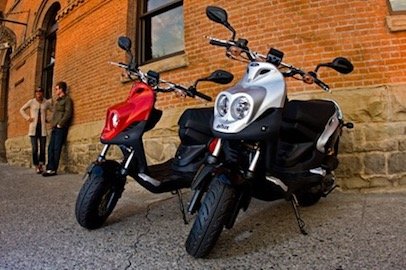
The Roughhouse has larger headlights too, but this change wasn’t because of the switch to the PMX design. Rather Genuine worked with PGO to design to the larger headlights and then added these to both the Roughhouse and Rattler 110 for 2008, and these headlights again appears on the Rattler 50 when it returned for 2019.
The 2019 resurrection of the Rattler 50 is basically the same machine as was offered a decade earlier, aside from a few tweaks. In addition to the larger headlights, it gains a larger rear rim (12” vs 10”) and mud booties on the fork stanchions (like the Roughhouse). So the 2019 Rattler 50 is essentially a blend of the original Rattler (exposed handlebars, street tires, fenders) and the more recent Roughhouse (larger headlights mud booties).
Engine
All of the sporty 2-stroke 50’s from Genuine (Rattler 50, Roughhouse and Black Cat) are powered by a horizontal Minarelli engine. This engine has been widely used worldwide for over two decades and has appeared in scooters from a huge range of brands besides Genuine, such as Yamaha, Aprilia and numerous Chinese makers. The Rattler 50 was restricted to 30mph from the factory (to meet moped classification), but derestriction is easy and increases top speed to about 48mph.
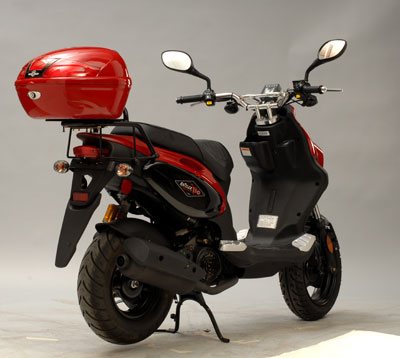
The Buck Ten was not restricted to a preconceived speed limit like the Rattler 50 (and many of other 50’s), but rather its overall power output was lowered as a result of restrictions necessary to meet tough emissions standards. To really uncage the Rattler 110, you need to do something about the small (19mm) carb and restrictive exhaust. A high performance variator is also a standard move. With these three areas dealt with, a Rattler 110 will be also need a few barbells or sand bags strapped to the front end to keep wheelies within reason. The truly power hungry can go further still and toss in planetary orbit bending modifications like 185cc kits. The ModernBuddy.com forums are a good resource for all your modification questions and discussion.
With its 2-stroke 110cc engine, the Rattler 110 was one of the largest 2-stroke scooters sold in the USA in the past 30 years (The Vespa PX150 and Genuine Stella 2-stroke being the other two main examples). Besides the PX and Stella, you have to look back to Honda’s 1984 Aero 125 to find a bigger 2-stroke scooter.
 Storage and Amenities
Storage and Amenities
The Rattler scooters have a nice amount of storage under the seat. The horizontal design of the Minarelli engine and tall-ish seat height frees up enough room for a helmet or quite a bit of gear. The 1.3 gallon fuel tank also shares the underseat area, which is why there isn’t more storage here. There is a small cubby hole on the legshield that is better than nothing, but no where near as handy as a proper glovebox.
The downside of the taller seat is that short riders will find the 32” high Rattler seat to be a lot to straddle. Genuine did shave the seat lower and move the rider position back a little for 2010, so these updated seats are nice for shorter riders or ones endowed with large feet.
For 2008 Genuine added a ‘Bay Boy’ super horn to all of their scooters, so the Rattler 110 is capable of deploying this heart stopper while the Rattler 50 makes do with a regular noise maker.
The underseat area in the Rattler includes a 12V charging spot which can be handy to power your cellphone or other toys. Genuine also sells a number of optional accessories for the Rattler which can be easily found on the Scooterworks website. These options include a windscreen, rear case and more.
One nice touch found on the Rattler is the digital dash. With the lack of a regular headset, there wasn’t room for a normal set of gauges so Genuine equipped the Rattler with a neat digital screen to display everything. Speed, fuel level, odometer, trip odometer and more are all succinctly displayed by this clever instrument.
Comparison
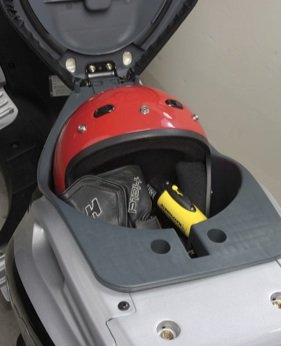
There’s lots of other small sporty 50’s that have a found their own niches in the North American market. These scooters include the Piaggio Typhoon, Aprilia Rally 50 and Kymco Super 8 and Super 9. The Rattler 50 competes by offering a strong value. The motor isn’t cutting edge technology, but it’s a great little 2-stroke engine that’s a proven performer with a huge aftermarket and accessory scene. It’s also well supported by a caring brand that isn’t too big to care about scooters, nor so small they’ll disappear in the night.
The Ratter 110 found a far more unique spot in the market during its 2008 – 2010 run. No one else sold a larger 2-stroke scooter in recent decades in the USA aside from a few Vespa PX’s and Genuine’s own Stella 150 2-stroke. In terms of performance the Rattler 110 competes with the 125-150cc 4-stroke scooters out there, but in reality most people buy a Rattler 110 because it’s a ridiculously peppy and fun scooter once a few simple engine mods are made. It’s an enthusiasts machine for 2-stroke performance fans, so kudos to Genuine for caring enough to cater to that.
Pros:
- Strong value
- Super peppy engines (once derestricted)
Cons:
- Tall seat in earlier years
- Lower power in stock form
Links:
Rattler 50 and 110 Service Manual – Great info for working your Rattler
MotorscooterGuide Forums – Visit the forums on this site to chat about this scoot.
Rattler 110 Review – Nice write up by JustGottaScoot
Motorcycle-USA Review – Detailed review of the Rattler 110
Key Specs:
- Engine: 2-stroke, air-cooled, 49.7cc or 106cc single
- Power: 4.8 HP @ 7000 RPM, 3.8 lbs-ft torque @ 6500 RPM (50cc), 9HP (110cc)
- Compression Ratio: 9.0:1 (50cc), 6.8 : 1 (110cc)
- Transmission: CVT
- Bore & Stroke: 40mm x 39.2mm (50cc) or 52mm x 50mm (110cc)
- Fuel Delivery: Carb
- Wheelbase: 46”
- Weight: 203 lbs (’06 – ’07 50cc), 209 lbs (110cc), 198 lbs (’19 50cc).
- Starter: Electric and Kick
- Seat height: 31” (50cc), 31-32” (110cc)
- Fuel Tank: 1.35 gallon
- Front Brake: 2 piston Disc
- Rear Brake: Drum
- Front Suspension: Telescoping Fork, 3.5” Travel
- Rear Suspension: Single Shock
- Rattler Tires (’06 – ’10): 120/70-12 (Front), 130/90-10 (Rear)
- Rattler Tires (2019): 120/70-12 (Front), 130/70-12 (Rear)
- USA MSRP: $2099 (2006 50cc), $2699 (110cc), $2399 (2019 50cc)
Colors:
- 2006 Rattler 50: Black
- 2007 Rattler 50: Black
- 2008 Rattler 110: Red/Black, Silver/Black
- 2009 Rattler 110: Red/Black, Silver/Black
- 2010 Rattler 110: Red/Black, Silver/Black
- 2019 Rattler 50: Black, Red

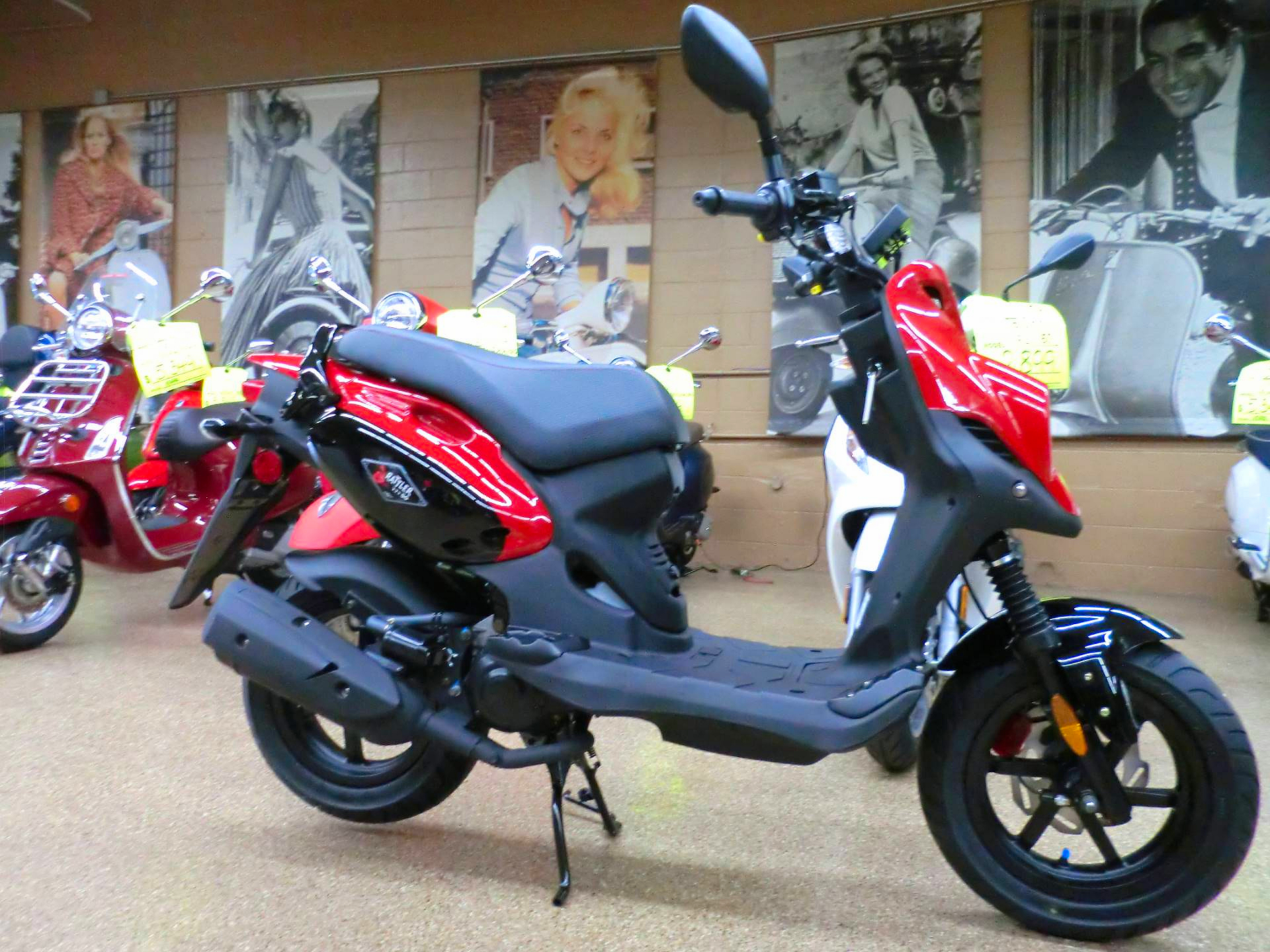
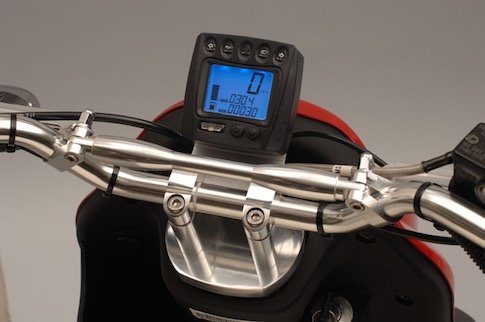 Storage and Amenities
Storage and Amenities